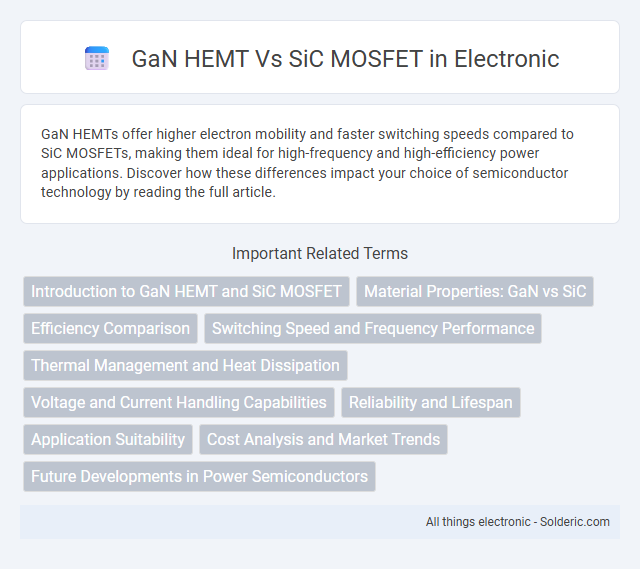GaN HEMTs offer higher electron mobility and faster switching speeds compared to SiC MOSFETs, making them ideal for high-frequency and high-efficiency power applications. Discover how these differences impact your choice of semiconductor technology by reading the full article.
Comparison Table
| Feature | GaN HEMT | SiC MOSFET |
|---|---|---|
| Material | Gallium Nitride (GaN) | Silicon Carbide (SiC) |
| Switching Speed | Ultra-fast, up to several MHz | Fast, typically up to a few hundred kHz |
| Voltage Rating | Typically 650V to 1200V | Typically 600V to 1700V |
| On-Resistance (RDS(on)) | Very low, enabling high efficiency | Low, but higher than GaN at equivalent voltage |
| Thermal Conductivity | Moderate (about 130 W/m*K) | High (about 370 W/m*K) |
| Gate Drive Voltage | Typically 5-6 V, sensitive to overvoltage | Typically 15-20 V, robust gate oxide |
| Application | High-frequency power conversion, RF amplifiers | High power, high temperature, industrial motor drives |
| Cost | Generally lower cost, emerging tech | Higher cost, established technology |
Introduction to GaN HEMT and SiC MOSFET
GaN HEMT (Gallium Nitride High Electron Mobility Transistor) features wide bandgap semiconductor properties enabling high electron mobility, which significantly improves switching speed and efficiency in power electronics. SiC MOSFET (Silicon Carbide Metal-Oxide-Semiconductor Field-Effect Transistor) offers superior thermal conductivity and high breakdown voltage, making it ideal for high-power and high-temperature applications. Both devices represent advanced wide bandgap technologies critical for enhancing power conversion efficiency in electric vehicles, renewable energy systems, and industrial motor drives.
Material Properties: GaN vs SiC
Gallium Nitride (GaN) exhibits a wider bandgap of approximately 3.4 eV compared to Silicon Carbide's (SiC) bandgap of about 3.3 eV, enabling higher breakdown voltages and improved thermal conductivity in GaN HEMTs. SiC MOSFETs offer superior electron mobility and stability at elevated temperatures due to their robust crystal structure, supporting high-power, high-temperature applications. The intrinsic material properties of GaN enable faster switching speeds and higher frequency operation, whereas SiC provides enhanced durability and reliability in harsh environments.
Efficiency Comparison
GaN HEMT devices typically offer higher efficiency than SiC MOSFETs due to their lower on-resistance and faster switching speeds, resulting in reduced conduction and switching losses. This translates to improved power conversion performance in applications like RF amplifiers and power supplies, where minimizing energy loss is critical. Your choice depends on balancing efficiency gains with factors such as thermal management and cost.
Switching Speed and Frequency Performance
GaN HEMTs exhibit superior switching speed and frequency performance compared to SiC MOSFETs due to their higher electron mobility and lower gate charge, enabling operation at frequencies exceeding several hundred MHz with minimal switching losses. SiC MOSFETs, while robust for high-voltage and high-temperature applications, typically operate efficiently at lower switching frequencies, usually below 1 MHz, due to their slower switching transitions and higher gate capacitance. This makes GaN HEMTs more suitable for applications demanding ultra-high frequency efficiency and rapid switching, such as RF power amplifiers and high-frequency power converters.
Thermal Management and Heat Dissipation
GaN HEMTs exhibit superior thermal conductivity and lower thermal resistance compared to SiC MOSFETs, enabling more efficient heat dissipation and improved thermal management in high-frequency power applications. SiC MOSFETs, while offering robust thermal stability at high voltages and temperatures, generally require more advanced cooling systems to manage heat buildup effectively. Your system's reliability and efficiency can significantly benefit from GaN HEMT technology due to its enhanced ability to maintain lower junction temperatures under high power density conditions.
Voltage and Current Handling Capabilities
GaN HEMTs exhibit superior voltage handling with breakdown voltages typically around 600-1200V, making them ideal for high-frequency, high-efficiency applications. SiC MOSFETs can handle higher voltages, often exceeding 1200V up to 3300V, and support higher current densities due to their robust thermal performance and wide bandgap properties. Your choice between GaN HEMT and SiC MOSFET largely depends on the specific voltage and current requirements of your power electronics system.
Reliability and Lifespan
GaN HEMTs typically exhibit higher electron mobility and faster switching speeds but face challenges in long-term reliability under high-stress conditions compared to SiC MOSFETs. SiC MOSFETs demonstrate superior thermal conductivity and robustness, resulting in enhanced lifespan and stable performance in high-temperature and high-voltage applications. The inherent material properties of SiC contribute to greater reliability in harsh environments, making it a preferred choice for applications demanding extended operational durability.
Application Suitability
GaN HEMTs excel in high-frequency applications such as RF amplifiers, 5G telecommunications, and fast-switching power converters due to their superior electron mobility and lower gate charge. SiC MOSFETs are better suited for high-voltage, high-temperature environments like electric vehicle inverters, industrial motor drives, and grid-tied solar inverters, offering robust thermal stability and high breakdown voltage. Both technologies optimize power efficiency but target distinct operational conditions based on frequency, voltage, and thermal requirements.
Cost Analysis and Market Trends
GaN HEMTs generally offer lower manufacturing costs due to simpler fabrication processes and smaller chip sizes, making them economically attractive for high-frequency applications. SiC MOSFETs, while more expensive upfront, provide superior thermal performance and robustness, driving higher adoption in high-power and automotive markets. Your choice depends on balancing initial investment against long-term efficiency benefits amid shifting market trends favoring GaN for fast-switching and SiC for high-voltage applications.
Future Developments in Power Semiconductors
Future developments in power semiconductors emphasize enhancing GaN HEMT performance with higher electron mobility and efficiency suitable for high-frequency applications, while SiC MOSFETs focus on improving thermal conductivity, voltage handling, and ruggedness for high-power and high-voltage environments. Research aims to reduce on-resistance and switching losses in GaN devices to support next-generation electric vehicles and 5G infrastructure. Meanwhile, SiC technology advances target wider adoption in renewable energy systems and industrial motor drives owing to superior high-temperature operation.
GaN HEMT vs SiC MOSFET Infographic

 solderic.com
solderic.com